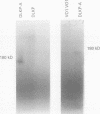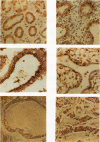Abstract
AIMS: The generation and characterisation of a monoclonal antibody that specifically recognises the mdr-1 encoded protein, P-glycoprotein (P-170), on routinely processed formalin fixed, paraffin wax embedded tissue sections. METHODS: The monoclonal antibody, designated 6/1C, was produced following a combination of in vivo and in vitro immunisation regimens in Balb/c mice with a synthetic 12 amino acid peptide that corresponds to amino acids 21-32 (believed to be intracellularly located) of P-170 and has insignificant homology with the mdr-3 encoded P-170. Antibody 6/1C was characterised by western blotting and immunocytochemistry on cytospins of paired multidrug resistant or sensitive cell lines, including mdr-1 and mdr-3 transfected cells, and by immunohistochemistry on normal and malignant formalin fixed paraffin wax embedded tissue sections. RESULTS: Antibody 6/1C showed a single band at 170 kDa on western blots of multidrug resistant cell lysates and mdr-1 transfected cell lysates that was absent on similar preparations of drug sensitive cells and mdr-3 transfected cells. Immunocytochemical studies on cytospins of multidrug resistant cells and mdr-1 transfected cells revealed strong inner plasma membrane/cytoplasmic staining. Staining was negligible on drug sensitive cells and cells transfected with the mdr-3 gene. Immunohistochemical studies on formalin fixed, paraffin wax embedded normal adult kidney, liver, and breast tissue and a range of fetal tissues exhibited staining patterns of a variety of secretory surfaces consistent with documented mdr-1 specific staining. Specific staining of malignant cells in similarly treated sections of breast tumours was seen also with antibody 6/1C. Staining on paraffin wax embedded tissue with this antibody did not require any pretreatment of tissue sections. CONCLUSIONS: This new monoclonal antibody, chosen for its specificity with the mdr-1 encoded P-170 and its reactivity on routinely fixed paraffin wax embedded tissue samples without pretreatment, appears to be useful for the investigation of P-170 in archival material. It is especially useful for retrospective studies on pretreatment and post-treatment tissue sections, and could help establish when and how rapidly mdr-1 associated drug resistance develops during chemotherapeutic regimens. Immunohistochemical assessment of P-170 expression in many cancers has potential for diagnostic purposes and may influence the choice of chemotherapeutic drugs used in the treatment of refractory tumours.
Full text
PDF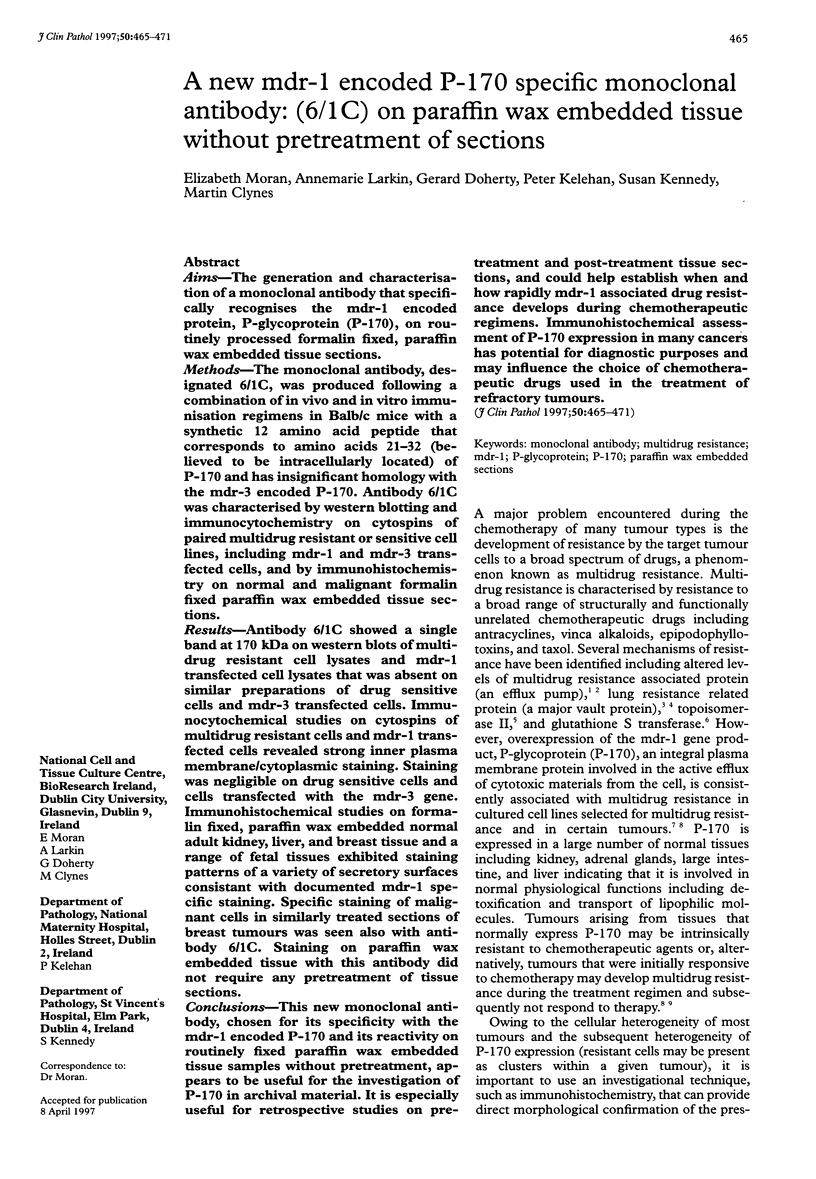
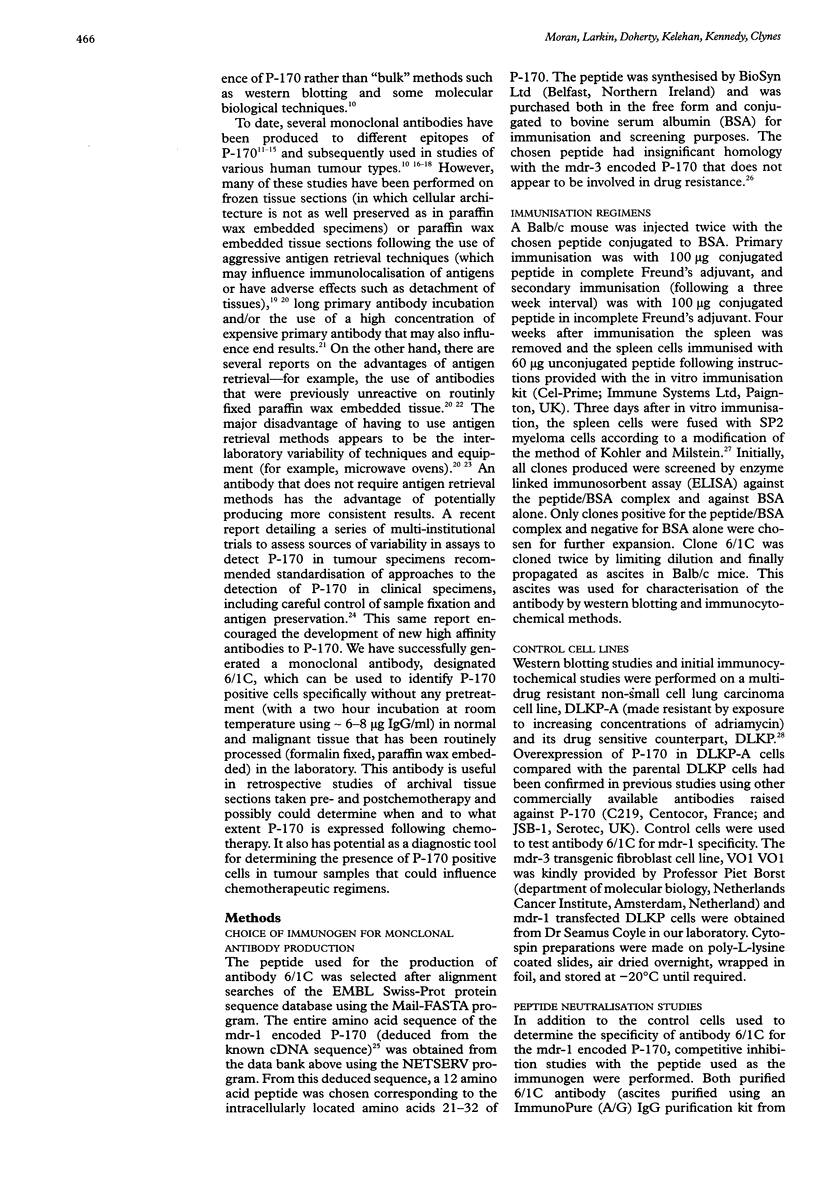
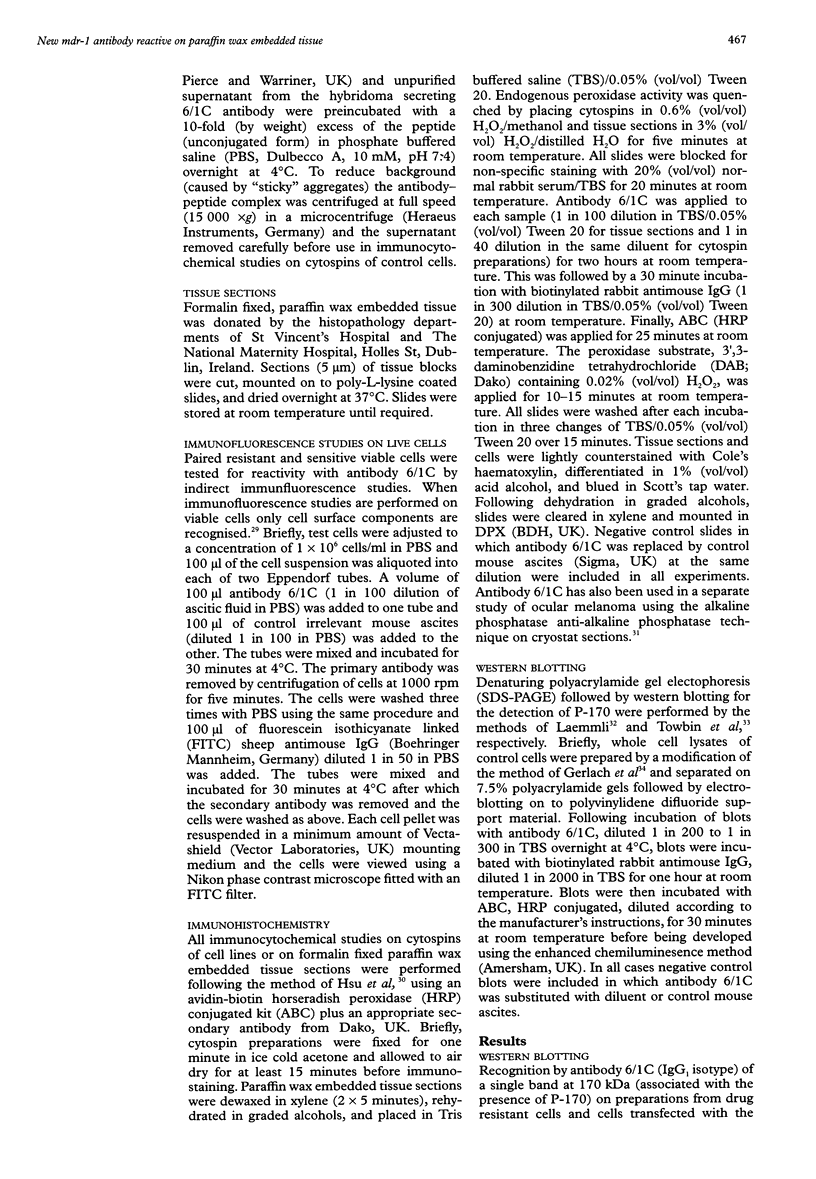
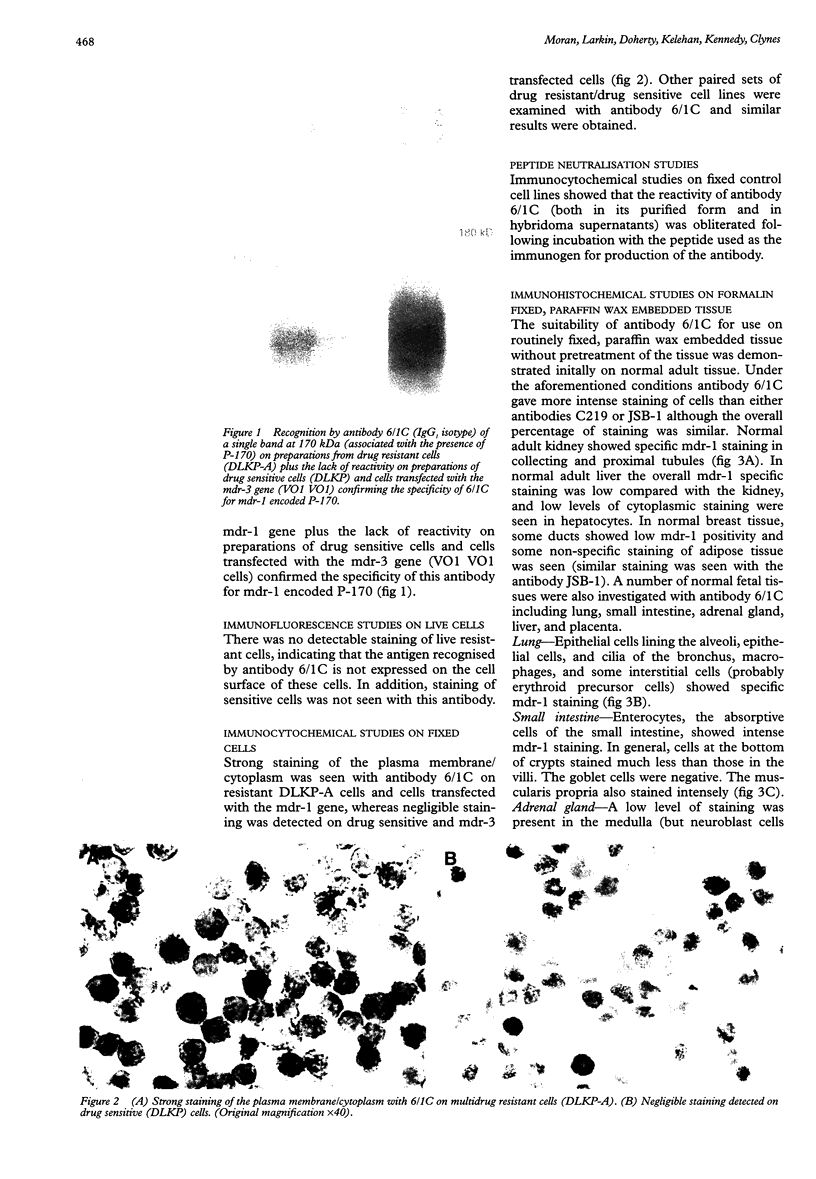
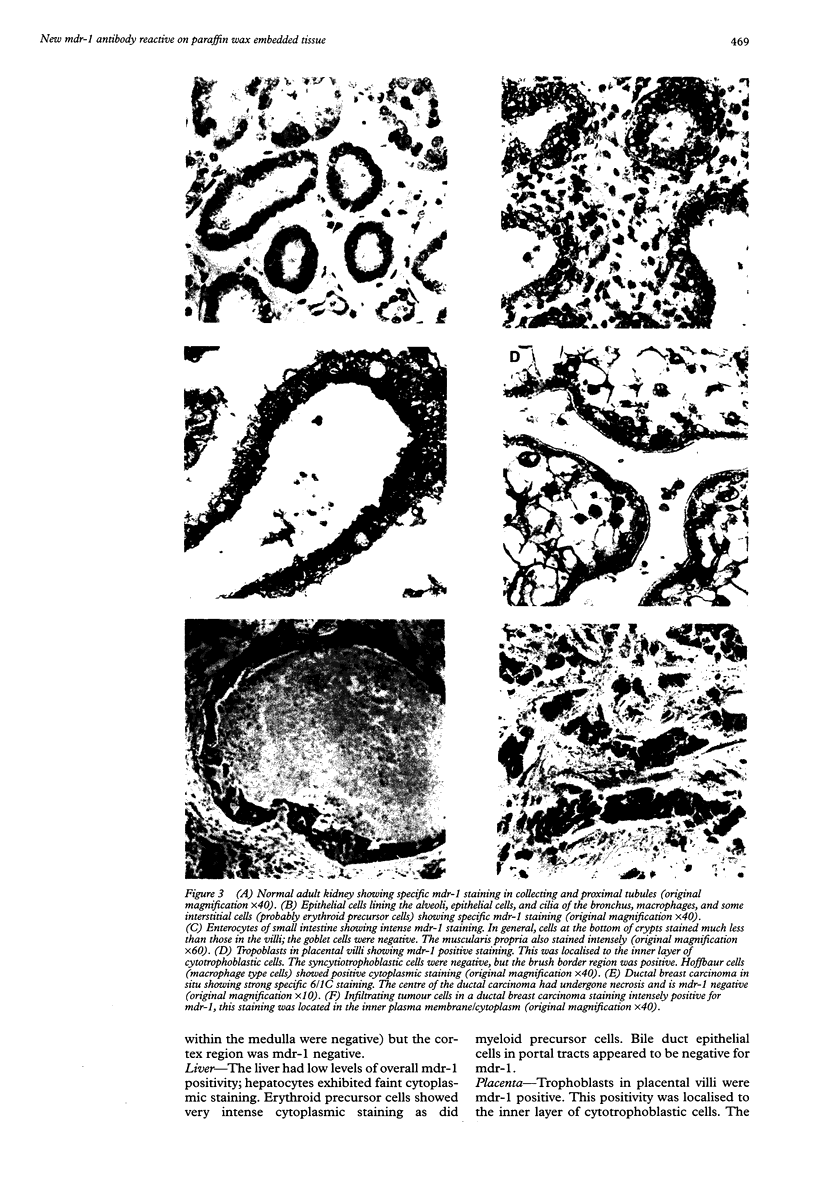
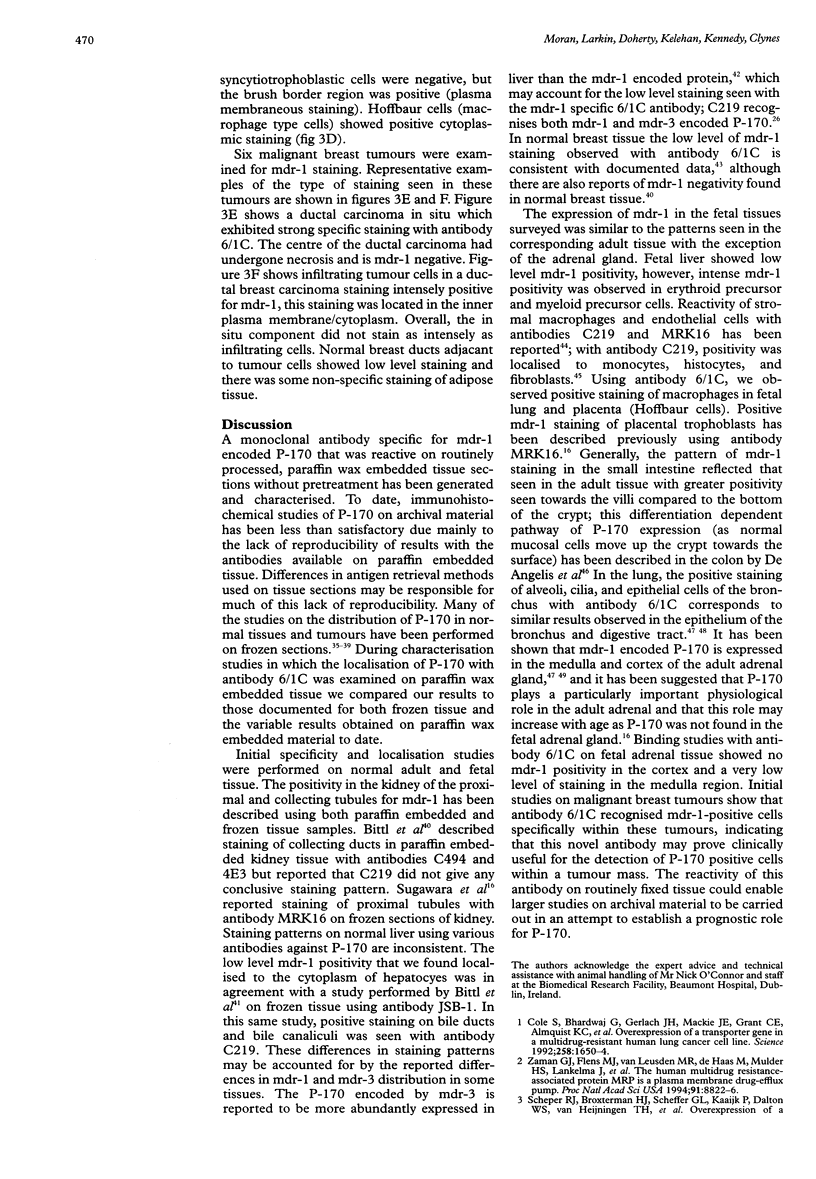
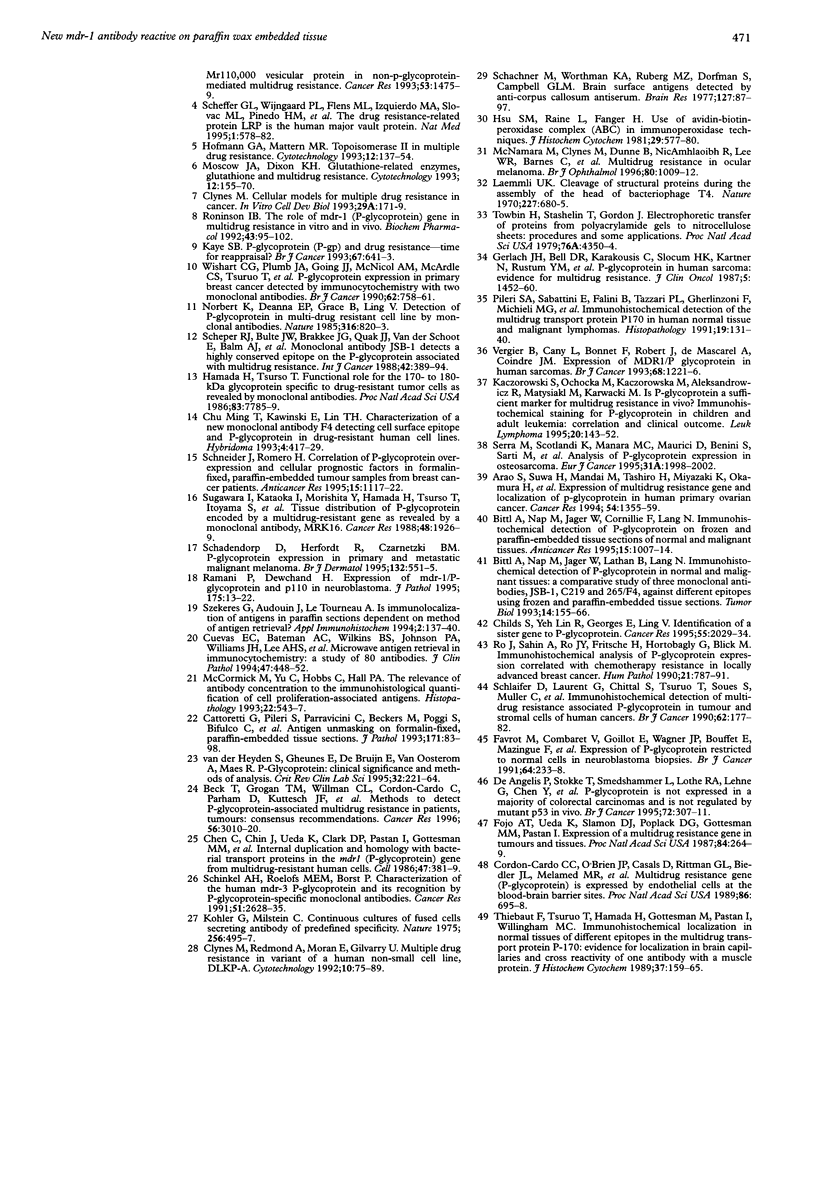
Images in this article
Selected References
These references are in PubMed. This may not be the complete list of references from this article.
- Arao S., Suwa H., Mandai M., Tashiro H., Miyazaki K., Okamura H., Nomura H., Hiai H., Fukumoto M. Expression of multidrug resistance gene and localization of P-glycoprotein in human primary ovarian cancer. Cancer Res. 1994 Mar 1;54(5):1355–1359. [PubMed] [Google Scholar]
- Beck W. T., Grogan T. M., Willman C. L., Cordon-Cardo C., Parham D. M., Kuttesch J. F., Andreeff M., Bates S. E., Berard C. W., Boyett J. M. Methods to detect P-glycoprotein-associated multidrug resistance in patients' tumors: consensus recommendations. Cancer Res. 1996 Jul 1;56(13):3010–3020. [PubMed] [Google Scholar]
- Bittl A., Nap M., Jäger W., Cornillie F., Lang N. Immunohistochemical detection of P-glycoprotein on frozen and paraffin-embedded tissue sections of normal and malignant tissues. Anticancer Res. 1995 May-Jun;15(3):1007–1014. [PubMed] [Google Scholar]
- Bittl A., Nap M., Jäger W., Lathan B., Lang N. Immunohistochemical detection of P-glycoprotein in normal and malignant tissues: a comparative study of three monoclonal antibodies, JSB-1, C 219 and 265/F4, against different epitopes using frozen and paraffin tissue sections. Tumour Biol. 1993;14(3):155–166. doi: 10.1159/000217831. [DOI] [PubMed] [Google Scholar]
- Cattoretti G., Pileri S., Parravicini C., Becker M. H., Poggi S., Bifulco C., Key G., D'Amato L., Sabattini E., Feudale E. Antigen unmasking on formalin-fixed, paraffin-embedded tissue sections. J Pathol. 1993 Oct;171(2):83–98. doi: 10.1002/path.1711710205. [DOI] [PubMed] [Google Scholar]
- Chen C. J., Chin J. E., Ueda K., Clark D. P., Pastan I., Gottesman M. M., Roninson I. B. Internal duplication and homology with bacterial transport proteins in the mdr1 (P-glycoprotein) gene from multidrug-resistant human cells. Cell. 1986 Nov 7;47(3):381–389. doi: 10.1016/0092-8674(86)90595-7. [DOI] [PubMed] [Google Scholar]
- Childs S., Yeh R. L., Georges E., Ling V. Identification of a sister gene to P-glycoprotein. Cancer Res. 1995 May 15;55(10):2029–2034. [PubMed] [Google Scholar]
- Chu T. M., Kawinski E., Lin T. H. Characterization of a new monoclonal antibody F4 detecting cell surface epitope and P-glycoprotein in drug-resistant human tumor cell lines. Hybridoma. 1993 Aug;12(4):417–429. doi: 10.1089/hyb.1993.12.417. [DOI] [PubMed] [Google Scholar]
- Clynes M. Cellular models for multiple drug resistance in cancer. In Vitro Cell Dev Biol. 1993 Mar;29A(3 Pt 1):171–179. doi: 10.1007/BF02634176. [DOI] [PubMed] [Google Scholar]
- Clynes M., Redmond A., Moran E., Gilvarry U. Multiple drug-resistance in variant of a human non-small cell lung carcinoma cell line, DLKP-A. Cytotechnology. 1992;10(1):75–89. doi: 10.1007/BF00376102. [DOI] [PubMed] [Google Scholar]
- Cordon-Cardo C., O'Brien J. P., Casals D., Rittman-Grauer L., Biedler J. L., Melamed M. R., Bertino J. R. Multidrug-resistance gene (P-glycoprotein) is expressed by endothelial cells at blood-brain barrier sites. Proc Natl Acad Sci U S A. 1989 Jan;86(2):695–698. doi: 10.1073/pnas.86.2.695. [DOI] [PMC free article] [PubMed] [Google Scholar]
- Cuevas E. C., Bateman A. C., Wilkins B. S., Johnson P. A., Williams J. H., Lee A. H., Jones D. B., Wright D. H. Microwave antigen retrieval in immunocytochemistry: a study of 80 antibodies. J Clin Pathol. 1994 May;47(5):448–452. doi: 10.1136/jcp.47.5.448. [DOI] [PMC free article] [PubMed] [Google Scholar]
- De Angelis P., Stokke T., Smedshammer L., Lothe R. A., Lehne G., Chen Y., Clausen O. P. P-glycoprotein is not expressed in a majority of colorectal carcinomas and is not regulated by mutant p53 in vivo. Br J Cancer. 1995 Aug;72(2):307–311. doi: 10.1038/bjc.1995.329. [DOI] [PMC free article] [PubMed] [Google Scholar]
- Favrot M., Combaret V., Goillot E., Wagner J. P., Bouffet E., Mazingue F., Thyss A., Bordigoni P., Delsol G., Bailly C. Expression of P-glycoprotein restricted to normal cells in neuroblastoma biopsies. Br J Cancer. 1991 Aug;64(2):233–238. doi: 10.1038/bjc.1991.282. [DOI] [PMC free article] [PubMed] [Google Scholar]
- Gerlach J. H., Bell D. R., Karakousis C., Slocum H. K., Kartner N., Rustum Y. M., Ling V., Baker R. M. P-glycoprotein in human sarcoma: evidence for multidrug resistance. J Clin Oncol. 1987 Sep;5(9):1452–1460. doi: 10.1200/JCO.1987.5.9.1452. [DOI] [PubMed] [Google Scholar]
- Hamada H., Tsuruo T. Functional role for the 170- to 180-kDa glycoprotein specific to drug-resistant tumor cells as revealed by monoclonal antibodies. Proc Natl Acad Sci U S A. 1986 Oct;83(20):7785–7789. doi: 10.1073/pnas.83.20.7785. [DOI] [PMC free article] [PubMed] [Google Scholar]
- Hofmann G. A., Mattern M. R. Topoisomerase II in multiple drug resistance. Cytotechnology. 1993;12(1-3):137–154. doi: 10.1007/BF00744662. [DOI] [PubMed] [Google Scholar]
- Hsu S. M., Raine L., Fanger H. Use of avidin-biotin-peroxidase complex (ABC) in immunoperoxidase techniques: a comparison between ABC and unlabeled antibody (PAP) procedures. J Histochem Cytochem. 1981 Apr;29(4):577–580. doi: 10.1177/29.4.6166661. [DOI] [PubMed] [Google Scholar]
- Kaczorowski S., Ochocka M., Kaczorowska M., Aleksandrowicz R., Matysiakl M., Karwacki M. Is P-glycoprotein a sufficient marker for multidrug resistance in vivo? Immunohistochemical staining for P-glycoprotein in children and adult leukemia: correlation with clinical outcome. Leuk Lymphoma. 1995 Dec;20(1-2):143–152. doi: 10.3109/10428199509054766. [DOI] [PubMed] [Google Scholar]
- Kartner N., Evernden-Porelle D., Bradley G., Ling V. Detection of P-glycoprotein in multidrug-resistant cell lines by monoclonal antibodies. 1985 Aug 29-Sep 4Nature. 316(6031):820–823. doi: 10.1038/316820a0. [DOI] [PubMed] [Google Scholar]
- Kaye S. B. P glycoprotein (P-gp) and drug resistance--time for reappraisal? Br J Cancer. 1993 Apr;67(4):641–643. doi: 10.1038/bjc.1993.119. [DOI] [PMC free article] [PubMed] [Google Scholar]
- Köhler G., Milstein C. Continuous cultures of fused cells secreting antibody of predefined specificity. Nature. 1975 Aug 7;256(5517):495–497. doi: 10.1038/256495a0. [DOI] [PubMed] [Google Scholar]
- Laemmli U. K. Cleavage of structural proteins during the assembly of the head of bacteriophage T4. Nature. 1970 Aug 15;227(5259):680–685. doi: 10.1038/227680a0. [DOI] [PubMed] [Google Scholar]
- McCormick D., Yu C., Hobbs C., Hall P. A. The relevance of antibody concentration to the immunohistological quantification of cell proliferation-associated antigens. Histopathology. 1993 Jun;22(6):543–547. doi: 10.1111/j.1365-2559.1993.tb00174.x. [DOI] [PubMed] [Google Scholar]
- McNamara M., Clynes M., Dunne B., NicAmhlaoibh R., Lee W. R., Barnes C., Kennedy S. M. Multidrug resistance in ocular melanoma. Br J Ophthalmol. 1996 Nov;80(11):1009–1012. doi: 10.1136/bjo.80.11.1009. [DOI] [PMC free article] [PubMed] [Google Scholar]
- Moscow J. A., Dixon K. H. Glutathione-related enzymes, glutathione and multidrug resistance. Cytotechnology. 1993;12(1-3):155–170. doi: 10.1007/BF00744663. [DOI] [PubMed] [Google Scholar]
- Pileri S. A., Sabattini E., Falini B., Tazzari P. L., Gherlinzoni F., Michieli M. G., Damiani D., Zucchini L., Gobbi M., Tsuruo T. Immunohistochemical detection of the multidrug transport protein P170 in human normal tissues and malignant lymphomas. Histopathology. 1991 Aug;19(2):131–140. doi: 10.1111/j.1365-2559.1991.tb00003.x. [DOI] [PubMed] [Google Scholar]
- Ramani P., Dewchand H. Expression of mdr1/P-glycoprotein and p110 in neuroblastoma. J Pathol. 1995 Jan;175(1):13–22. doi: 10.1002/path.1711750104. [DOI] [PubMed] [Google Scholar]
- Ro J., Sahin A., Ro J. Y., Fritsche H., Hortobagyi G., Blick M. Immunohistochemical analysis of P-glycoprotein expression correlated with chemotherapy resistance in locally advanced breast cancer. Hum Pathol. 1990 Aug;21(8):787–791. doi: 10.1016/0046-8177(90)90046-8. [DOI] [PubMed] [Google Scholar]
- Roninson I. B. The role of the MDR1 (P-glycoprotein) gene in multidrug resistance in vitro and in vivo. Biochem Pharmacol. 1992 Jan 9;43(1):95–102. doi: 10.1016/0006-2952(92)90666-7. [DOI] [PubMed] [Google Scholar]
- Schachner M., Wortham K. A., Ruberg M. Z., Dorfman S., Campbell G. L. Brain cell surface antigens detected by anti-corpus callosum antiserum. Brain Res. 1977 May 20;127(1):87–97. doi: 10.1016/0006-8993(77)90381-x. [DOI] [PubMed] [Google Scholar]
- Schadendorf D., Herfordt R., Czarnetzki B. M. P-glycoprotein expression in primary and metastatic malignant melanoma. Br J Dermatol. 1995 Apr;132(4):551–555. doi: 10.1111/j.1365-2133.1995.tb08710.x. [DOI] [PubMed] [Google Scholar]
- Scheffer G. L., Wijngaard P. L., Flens M. J., Izquierdo M. A., Slovak M. L., Pinedo H. M., Meijer C. J., Clevers H. C., Scheper R. J. The drug resistance-related protein LRP is the human major vault protein. Nat Med. 1995 Jun;1(6):578–582. doi: 10.1038/nm0695-578. [DOI] [PubMed] [Google Scholar]
- Scheper R. J., Broxterman H. J., Scheffer G. L., Kaaijk P., Dalton W. S., van Heijningen T. H., van Kalken C. K., Slovak M. L., de Vries E. G., van der Valk P. Overexpression of a M(r) 110,000 vesicular protein in non-P-glycoprotein-mediated multidrug resistance. Cancer Res. 1993 Apr 1;53(7):1475–1479. [PubMed] [Google Scholar]
- Scheper R. J., Bulte J. W., Brakkee J. G., Quak J. J., van der Schoot E., Balm A. J., Meijer C. J., Broxterman H. J., Kuiper C. M., Lankelma J. Monoclonal antibody JSB-1 detects a highly conserved epitope on the P-glycoprotein associated with multi-drug-resistance. Int J Cancer. 1988 Sep 15;42(3):389–394. doi: 10.1002/ijc.2910420314. [DOI] [PubMed] [Google Scholar]
- Schinkel A. H., Roelofs E. M., Borst P. Characterization of the human MDR3 P-glycoprotein and its recognition by P-glycoprotein-specific monoclonal antibodies. Cancer Res. 1991 May 15;51(10):2628–2635. [PubMed] [Google Scholar]
- Schlaifer D., Laurent G., Chittal S., Tsuruo T., Soues S., Muller C., Charcosset J. Y., Alard C., Brousset P., Mazerrolles C. Immunohistochemical detection of multidrug resistance associated P-glycoprotein in tumour and stromal cells of human cancers. Br J Cancer. 1990 Aug;62(2):177–182. doi: 10.1038/bjc.1990.256. [DOI] [PMC free article] [PubMed] [Google Scholar]
- Schneider J., Romero H. Correlation of P-glycoprotein overexpression and cellular prognostic factors in formalin-fixed, paraffin-embedded tumor samples from breast cancer patients. Anticancer Res. 1995 May-Jun;15(3):1117–1121. [PubMed] [Google Scholar]
- Serra M., Scotlandi K., Manara M. C., Maurici D., Benini S., Sarti M., Campanacci M., Baldini N. Analysis of P-glycoprotein expression in osteosarcoma. Eur J Cancer. 1995 Nov;31A(12):1998–2002. doi: 10.1016/0959-8049(95)00335-5. [DOI] [PubMed] [Google Scholar]
- Sugawara I., Kataoka I., Morishita Y., Hamada H., Tsuruo T., Itoyama S., Mori S. Tissue distribution of P-glycoprotein encoded by a multidrug-resistant gene as revealed by a monoclonal antibody, MRK 16. Cancer Res. 1988 Apr 1;48(7):1926–1929. [PubMed] [Google Scholar]
- Thiebaut F., Tsuruo T., Hamada H., Gottesman M. M., Pastan I., Willingham M. C. Immunohistochemical localization in normal tissues of different epitopes in the multidrug transport protein P170: evidence for localization in brain capillaries and crossreactivity of one antibody with a muscle protein. J Histochem Cytochem. 1989 Feb;37(2):159–164. doi: 10.1177/37.2.2463300. [DOI] [PubMed] [Google Scholar]
- Towbin H., Staehelin T., Gordon J. Electrophoretic transfer of proteins from polyacrylamide gels to nitrocellulose sheets: procedure and some applications. Proc Natl Acad Sci U S A. 1979 Sep;76(9):4350–4354. doi: 10.1073/pnas.76.9.4350. [DOI] [PMC free article] [PubMed] [Google Scholar]
- Vergier B., Cany L., Bonnet F., Robert J., de Mascarel A., Coindre J. M. Expression of MDR1/P glycoprotein in human sarcomas. Br J Cancer. 1993 Dec;68(6):1221–1226. doi: 10.1038/bjc.1993.508. [DOI] [PMC free article] [PubMed] [Google Scholar]
- Wishart G. C., Plumb J. A., Going J. J., McNicol A. M., McArdle C. S., Tsuruo T., Kaye S. B. P-glycoprotein expression in primary breast cancer detected by immunocytochemistry with two monoclonal antibodies. Br J Cancer. 1990 Nov;62(5):758–761. doi: 10.1038/bjc.1990.373. [DOI] [PMC free article] [PubMed] [Google Scholar]
- Zaman G. J., Flens M. J., van Leusden M. R., de Haas M., Mülder H. S., Lankelma J., Pinedo H. M., Scheper R. J., Baas F., Broxterman H. J. The human multidrug resistance-associated protein MRP is a plasma membrane drug-efflux pump. Proc Natl Acad Sci U S A. 1994 Sep 13;91(19):8822–8826. doi: 10.1073/pnas.91.19.8822. [DOI] [PMC free article] [PubMed] [Google Scholar]
- van der Heyden S., Gheuens E., DeBruijn E., Van Oosterom A., Maes R. P-glycoprotein: clinical significance and methods of analysis. Crit Rev Clin Lab Sci. 1995;32(3):221–264. doi: 10.3109/10408369509084685. [DOI] [PubMed] [Google Scholar]



